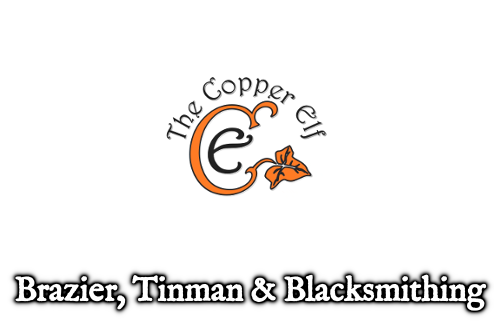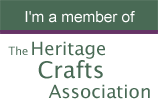|
Copper
Care |
CARING FOR COPPERCopper is an amazing material; copper and her alloys have a wide range colours from deep orange-reds to bright golden-yellows. Copper has very useful thermal properties for cooking, it heats quickly and uniformly making it ideal for cookware. Copper and brass do not allow bacteria to live on their surfaces, historically hospitals used brass door handles and equipment which helped reduce the spread of infections without the need of disinfectants; this property is also useful in food production. Traditionally in French cooking bowls for whisking eggs are bare copper or brass as there is a reaction between the copper and egg white that creates bigger and stronger bubbles.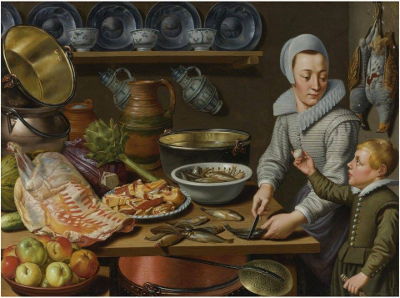 Floris van Schooten : Kitchen Still-Life (Early 17th Centruy) The outside of the kettles have gone black in the soot of the fire but the inside of the ketlles are perfectly clean to prevent tainting of the contents. ISSUES WITH COPPERCopper and brasses have to be kept clean and dry or they rapidly dull in colour (which is sometimes desirable). If coppers are left damp they develop a green powdery oxidised finish called "verdigris" or copper(II) acetate. Verdigris can be used as a decorative finish but it must always be remembered that verdigris is toxic and if present on cookware can cause vomiting. The effects of verdigris has lead to the misunderstanding that copper cookware will make you ill and all copper must be "tinned", coated with a thin layer of tin to prevent the food coming into contact with the copper. Whilst the copper acetate poisoning from ingesting is unpleasant in humans it is not fatal, but, it should always be avoided.Keeping copper clean and dry prevents verdigris and prevents ill effects, however certain foods can react with copper creating copper acetates very rapidly and should be avoided. Acidic foods should not be cooked or stored in copper; the main ingredients to avoid are tomatoes, vinegar and citrus fruit. Until recently there was no need to tin copper pots because citrus fruits and tomatoes were not widely available in Europe and the designs of copperware allowed them to be easily cleaned and dried. If the shape of your vessel prevents you from cleaning all the internal surfaces it should be tinned. If you are cooking vinegars or acidic foods your pan should be tinned. If you are not keen on the idea of careful cleaning after every use then the pan or vessel should be tinned. Historically copper, brass and bronze have been used much more than iron for kettles, pots, skillets and utensils because if cared for correctly they work better and iron is more suited for other jobs where material strength is more important. 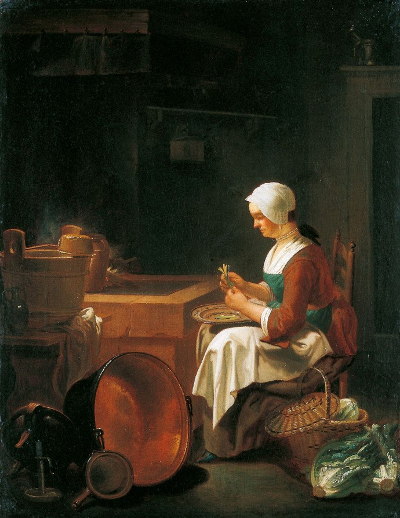 Justus Juncker : De Magd in der küche (Mid 18th Century) A very large copper kettle, well blackened outside from use but kept perfectly clean inside. ISSUES WITH TINNINGTinned pans present their own issues. You cannot use metal utensils in a tinned pan, doing so will scratch the tin and exposes the copper, this exposed copper is very difficult to see or clean and will create verdigris in the scratches. Never use a scourer on tinned surfacesYou should not fry or melt sugar in a tinned pan. Frying does not transmit the heat out of the metal because frying temperatures are over 300° Celsius, tin melts at 261° which means as you fry you can easily remove the tinned surface. Sugar is much the same, when the sugar has melted the heat is no longer removed from the metal and the tin will melt; traditionally confectionary pans and jam pans are never tinned. During jam making the sugar reacts with the acids in the fruits creating a non-oxidising acid and therefore does not create copper acetates during cooking. Boiling dry is the worst for a tinned pan, you should not leave a tinned copper pan unattended. When all the water has evaporated there is nothing removing the heat from the metal and the tin soon melts contaminating your burnt food. A further problem is the molten tin can cause the copper it is in contact with to melt at a much lower temperature than normal and you burn a hole in your pan. Many old style techniques for making pans and vessels involve soldered joints which are not visible under the tinning, if the tinning melts the soldered joints will melt too as the solder used in cookware is pure tin, when this happens the vessel will fall apart unless it is also riveted. Joints can also be braised, this will look like golden solder, which will withstand much higher temperatures but that is no excuse for boiling dry! 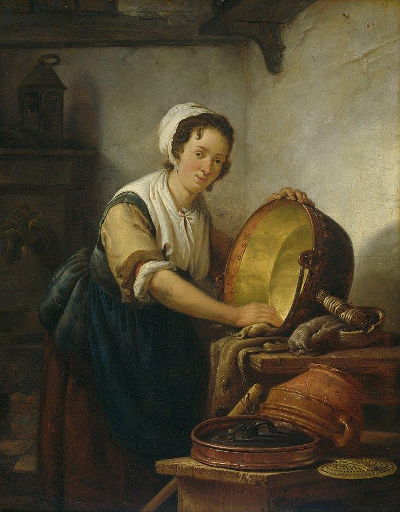 Abraham van Strij : The Caldron Scrubber (1808-1810) A painting showing how kettles were cleaned. This beautiful brass and copper kettle has been scrubbed with a bundle of straw or broom twigs to remove everything from the surface of the metal and is now being thoroughy dried with a cloth. CLEANING COPPERNow we know the does and don'ts of bare copper and tinned copper we can look at cleaning the objects. Tinned objects should be washed in warm soapy water without scouring and then immediately dried with a clean cloth to prevent the tin blackening or the outside copper surfaces going green.Copper can be cleaned in many ways depending on the object. Focusing on cookware the best method is to wash it as you would tinned objects directly after use; this will prevent tarnishing or developing verdigris. Traditionally pots and kettles that hung over fires were allowed to go black on the outside, this black layer of soot can be polished to a shine with a damp cloth and prevents the vessel of developing verdigris on the outside; the inside was always spotless. If your copper or brass has dulled or has verdigris a good means of removing it is acid and scouring. Lemon juice or vinegar are very good at cleaning copper. Above you were advised not to put citric or acetic acids in your copper, this is true when cooking, but for cleaning they are excellent. If you have a tarnished pan (or any tarnished copper object) squeeze fresh lemon juice on to it, the lemon juice will turn black very quickly as the acid attacks the surface of your copper, rub with a scourer and the piece will come clean. Traditionally copper was cleaned with a cut lemon sprinkled with salt as a scouring agent or with a cloth, vinegar and salt; modern scouring pads are very good however they will leave your copper or brass with a matt finish. Using a soft cloth will work but it is a much slower process using more acid, this finish however is more gloss. When you have cleaned your piece you must thoroughly wash off the acid and then thoroughly dry it. Any acid left on the piece will cause the surface to tarnish or in serious cases go blue, in the case of some brass it will go copper coloured as the zinc is removed from the surface leaving just copper. If this discolouration does happen then you need to use a fine abrasive to remove the damaged surface. If the piece is left damp where the water is verdigris will form and you will need to clean again from the start. For surfaces that are not in contact with food commercial brass polished such as Brasso are very good but be sure to remove all the polish when buffing to prevent tarnish and verdigris developing where you have missed. Industrial cleaning of copper and brass involves much stronger acids and is not recommended for home cleaning, abrasive and buffing wheels with cutting waxes are also used to create high gloss finishes. The Copper Elf is able to clean copper objects for you or advise how your object should be cleaned.  |
Unit 3 Sidegate Works
Finedon Road
Wellingborough
Northamptonshire
NN8 4BW
07949 821518
Facebook Copperelf
Google Maps
